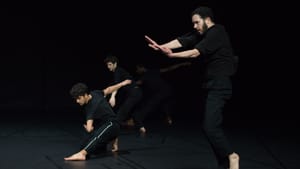Stay in the Loop
BSR publishes on a weekly schedule, with an email newsletter every Wednesday and Thursday morning. There’s no paywall, and subscribing is always free.
Aurora borealis of sound and movement
Philly Fringe 2017: 'A Love Supreme'

I am very familiar with John Coltrane’s music. But while watching this year’s Curated Philly Fringe Festival closer — Salva Sanchis and Anne Teresa de Keersmaeker's (Rosas) choreographed version of Coltrane’s highly spiritual A Love Supreme — at first I could not see its treeline, much less feel for the metaphors to write about it.
"A prayer and chant for love"
The four basic notes in Coltrane’s iconic 1964 album slip back and forth through all 12 keys. Its ascending emphasis and swelling beauty is jazz, of course, but also way beyond. A transformative work for Coltrane, it is a prayer and chant for love, boldly involving God, universality, black identity, Africa, and more.
Sanchis, a Spanish choreographer, graduated from De Keersmaeker’s P.A.R.T.S. school in Brussels, where dancers from around the world go to study. Sanchis collaborated with De Keersmaeker in 2005 on a shorter version of this work, and they recently expanded the piece into a full-evening program. It’s now danced by four men who each channel the style of the original ensemble, which included Philadelphian McCoy Tyner on piano, bassist Jimmy Garrison, drummer Elvin Jones, and of course, ‘Trane, as he came to be called, on tenor saxophone.
In the first 10 minutes or so, arms scythed the air; circular lifts and formations ended in reverse revolutions. A silent prelude, the choreography mapped out a meditation. It had a similar quality to what I’ve seen Yaqui Indians do at a Pasqua Deer Dance. They “dance the rosary” in silent reverie for three hours before entering their temple, which, for that weekend, is Christ’s tomb.
A man for each instrument
The tallest man, Belgian dancer Thomas Vantuycom, was ‘Trane’s sax. He pointed his forefinger to the floor as the music began with its iconic gong. The four dancers walked into their movement phrases, heads down in thought, reminding me of the way jazz musicians walk onto their sets. I began to experience moments of chromesthesia that transposed sound to color, and I felt that the dancers’ bodies and gestures painted the music in colors similar to what I saw.
Steps cascaded in shades of blue like the omnipresent four notes in their ever-changing keys. Swede Robin Haghi took McCoy’s silvery and pearly piano tones into short glissandos that raced back and forth. Vantuycom snapped his neck and shanked his shoulders down hard in a blast of yellowed moves.
Brazilian dancer José Paulo dos Santos took the drum solos and, as the beats ballooned out loudly, his chest swelled with pride and his smile appeared, full and sweet. The brushes riding the cymbal feathered to hushed shades, and Dos Santos cantered around the stage, coming to a stand close enough to lay some sweat on us. Then he lunged to the side, rapidly reversing his course to leave us in a bronzed haze.
Belgian Jason Respilieux played the bass parts like an archer. His arrow-straight arms took aim at the space, while his fletched hands stabilized their approach. His movements took on shades of red as the attenuated bass strings had his landings go softer.
The down-tempo fourth movement, "Psalms," is actually set to a poem by Coltrane that is on the album. He wanted the album to be "a whole expression of one's being.” The four dancers joined in again with movement lifts that did express the holy aurora borealis of sound Coltrane achieved.
What, When, Where
A Love Supreme. Music by John Coltrane, choreographed by Salva Sanchis and Anne Teresa De Keersmaeker. September 22-24, 2017, at Fringe Arts, 140 N. Columbus Boulevard, Philadelphia. (215) 413-1318 or fringearts.com.
Sign up for our newsletter
All of the week's new articles, all in one place. Sign up for the free weekly BSR newsletters, and don't miss a conversation.

 Merilyn Jackson
Merilyn Jackson